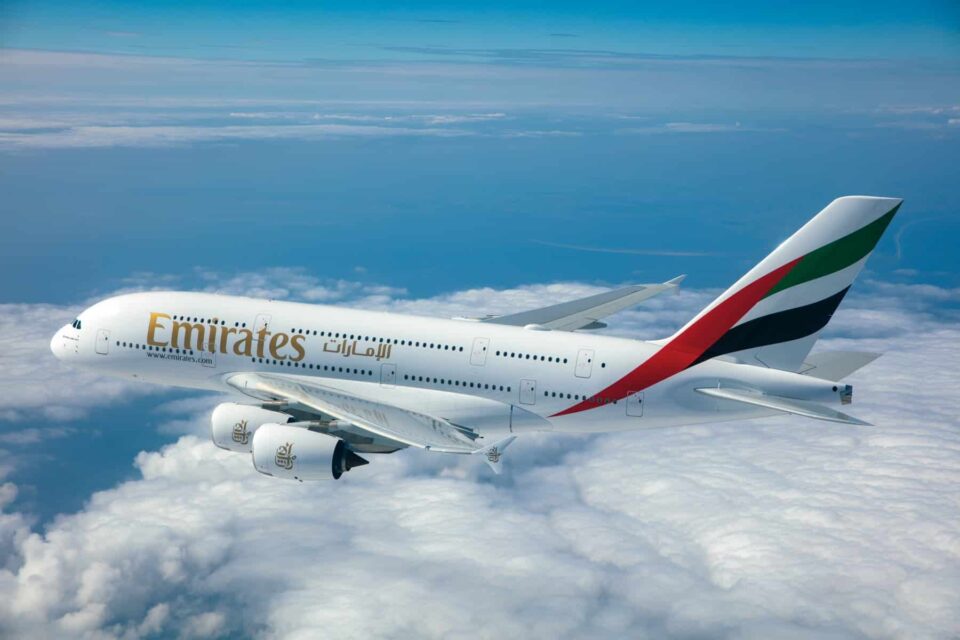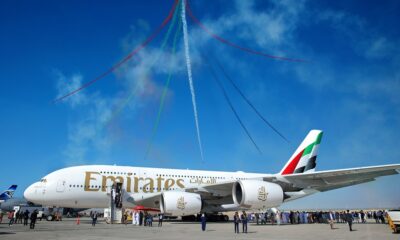Airlines
Emirates recycles more than 500,000 kilograms of plastic and glass in one year

Emirates has recycled more than 500,000 kilograms of plastic and glass over the course of 2022, by collecting discarded bottles onboard for repurposing. 500,000 kilograms is almost the same weight as a fully loaded Emirates flagship A380 aircraft.
Onboard every flight that lands in Dubai, Emirates Cabin Crew work hard to quickly separate glass and plastic bottles, before they are sent to a recycling plant in Dubai. The glass is separated by colour and crushed. This ‘cullet’ or recycled glass that is ready to be re-melted, is then sent to glass manufacturers in the UAE to include in their batch mix for new bottles. The plastic bottles are cleaned, chopped into flakes, melted into pellets, and sent to manufacturers to make other plastic products. As a result, Emirates and Emirates Flight Catering divert thousands of kilograms of glass and plastic away from landfill each year.
Alaska Airlines eliminates inflight plastic cups(Opens in a new browser tab)
The glass and plastic recycling initiative onboard was suggested by environmentally conscious Emirates Cabin Crew in 2019, as part of regular webinars and events where they are given a platform to share feedback and encouraged to share innovative ideas to key departments. The proposal was well-received and implemented within weeks.
Emirates blankets made from recycled plastic
For the last 6 years, Emirates has offered cosy sustainable blankets made from recycled plastic bottles to Economy passengers on long haul flights. The soft and warm blankets are made from 28 recycled plastic bottles. The fine thread is then woven into soft blankets. Over the 6 years since the initiative was introduced, Emirates blankets have prevented more than 95 million plastic bottles from going to landfill. As the largest sustainable blanket programme on board in the airline industry, the manufacturing process of using recycled polyethylene terephthalate (rPET) also reduces energy emissions by around 70%.
Prioritising responsible sourcing
Consuming responsibly is a key environmental focus area for Emirates, who have embedded an environmental requirement in the supplier code of conduct and consider the entire lifecycle of products from the design stage. For example, wooden tea and coffee stirrers, paper straws and inflight retail bags are made using wood and paper from responsibly managed forests.
Emirates children’s toys made from sustainably sourced material
For Emirates’ youngest customers, the airline’s complimentary toy bags, baby amenity kits and plush toys are also made from recycled plastic bottles and other sustainable materials. Belt bags, duffle bags and backpacks are designed with specific age groups in mind and are constructed from a yarn that is made from 100% recycled plastic bottles. Each Emirates kids’ backpack is made from 5.5 recycled plastic bottles and each duffle bag is made from 7. The production of the Emirates children’s bags has saved 8 million plastic bottles from landfill. The swing tags are made from recycled card, and even the outer cases that the products are shipped in are made from recycled card that can be recycled again.
Emirates reusable onboard amenity kits
Emirates’ Premium Economy and Economy Class range of amenity kits are complimentary for customers on long-haul flights, and feature designs that represent the four essential elements of nature – fire, water, earth, and air. The pouches are reusable and made from washable kraft paper with bespoke art printed in non-toxic soy-based ink. The contents include a selection of durable travel essentials made from environmentally friendly materials. The toothbrush is made from a combination of wheat straw and plastic, and the socks and eyeshades are made from recycled plastic, in this case, rPET (recycled polyethylene terephthalate). The packaging used for the dental kit, socks and eyeshades is made from 90 per cent rice paper.

Airlines
Air India’s last VVIP Boeing 747 now found a new home in USA

In a symbolic transition marking the end of a storied chapter in aviation history, Air India bid farewell to its last remaining Boeing 747-400 jumbo jetliners, once revered for ferrying dignitaries including prime ministers, presidents, and vice presidents.
The sale of these iconic aircraft to AerSale, a company based in the United States, signals the closure of a remarkable era for the airline.
The decision to part ways with the Boeing 747s was driven by practical considerations. Tata Group, the new custodian of airindia flights, deemed these majestic planes uneconomical to operate in today’s aviation landscape. As such, out of the four sold, two will be repurposed into freighters, while the remaining pair will be meticulously disassembled to harness their valuable parts.
The transaction, orchestrated by Mumbai-based Vman Aviation Services, underscores the strategic shift in Air India’s fleet management strategy under its new ownership. Tata Group’s decision to divest from the 747s reflects a commitment to optimizing operational efficiency and aligning with contemporary industry standards.
Skytech-AIC, a UK-based remarketing firm engaged by Tata Group, facilitated the sale of these iconic aircraft, marking the conclusion of their illustrious service with Air India. The airline’s last flight featuring the Boeing 747 took to the skies between Delhi and Mumbai in March 2021, encapsulating decades of distinguished service and indelible memories.
The allure of used aircraft parts continues to resonate across the aviation sector, offering operators a cost-effective alternative without compromising on quality or performance. The transfer of these aircraft to AerSale not only ensures their continued utility but also underscores the enduring legacy of Air India’s fleet.
Airlines
A software error caused grounding the entire airline fleet

On Wednesday, the U.S. Federal Aviation Administration (FAA) issued a ground stop advisory for all Alaska Airlines and subcarrier flights due to a software issue, disrupting travel plans for passengers.
The FAA directive, which prohibited the departure of Alaska Airlines mainline and subcarrier flights, was implemented as a precautionary measure following the detection of the software problem. The ground stop was initiated after Alaska Airlines encountered difficulties during a system upgrade related to the calculation of weight and balance for their flights.
As a result, the airline opted for a temporary suspension of all its operations to address the issue and ensure passenger safety. Alaska Airlines promptly issued a statement acknowledging the incident and expressing their commitment to resolving the matter swiftly. “This morning we experienced an issue while performing an upgrade to the system that calculates our weight and balance.
Out of an abundance of caution, we requested a ground stop for all Alaska and Horizon flights, which was instituted at approximately 7:30 a.m. PT,” the statement read. Passengers affected by the disruption voiced their concerns on social media platforms, prompting Alaska Airlines to reassure them of their efforts to minimize the inconvenience and expedite the resumption of flights.
Following approximately an hour-long interruption, the FAA lifted the ground stop order, allowing Alaska Airlines and its subcarriers to resume normal operations. However, it was clarified that SkyWest, which provides regional service for Alaska Airlines and other carriers, was exempt from the ground stop and continued its flights unaffected.
Aerospace
Which is bigger 777x or 787 aircraft ?

The 777X is a new series of the Boeing 777 family and is designed to be larger and more efficient than its predecessor. It features two variants: the 777-8 and the 777-9, being the larger of the two.
The Boeing 777X emerges as the larger sibling within the Boeing family, representing a significant leap forward in both size and efficiency. Comprising two variants, the 777-8 and the 777-9, the latter takes the crown as the larger of the two. With its expansive fuselage and impressive wingspan, the 777X is tailored for long-range journeys and boasts a substantial passenger capacity.
On the other hand, the Boeing 787, affectionately known as the Dreamliner, occupies a niche in the market as a smaller yet formidable aircraft designed for medium to long-range flights. Its distinguishing feature lies in its composite fuselage, a technological marvel that renders it lighter and more fuel-efficient compared to conventional aluminum counterparts. The Boeing 777X is larger than the Boeing 787 aircraft.
When it comes to passenger capacity, the 777-9 reigns supreme, typically accommodating a sizeable contingent of 400-425 passengers in its standard configuration. In contrast, the 787, with its more modest dimensions, typically carries between 240-290 passengers, depending on the variant and layout.
One of the remarkable innovations introduced with the 777X is its folding wingtips, a feature designed to address the logistical challenges of accommodating such a large aircraft in conventional airport gates. These folding wingtips enable the 777X to retract its wings, allowing it to fit into gates designed for smaller aircraft while still reaping the benefits of an extended wingspan during flight, thereby enhancing fuel efficiency and operational flexibility





























